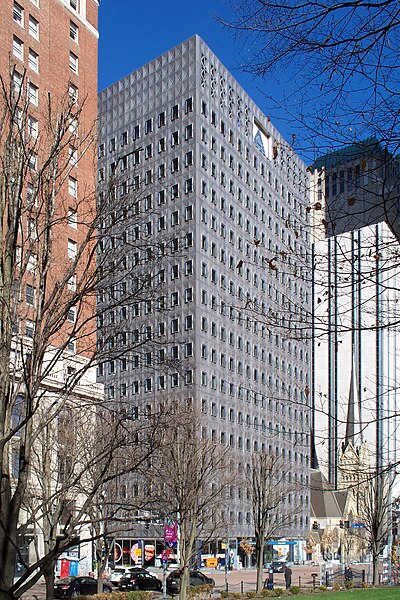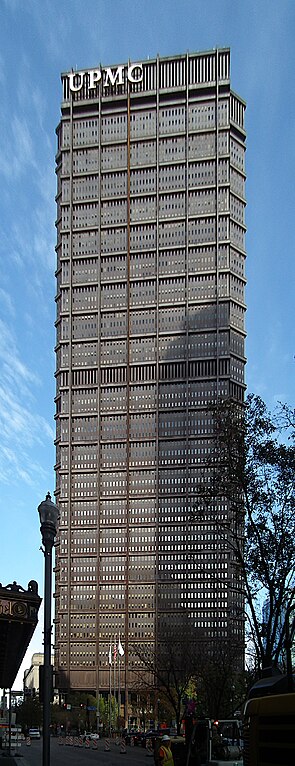
Four Gateway Center rendered in old-postcard colors for no particular reason.
Comments

Four Gateway Center rendered in old-postcard colors for no particular reason.

To old Pa Pitt’s eye, this is the most charming part of the Alcoa Building, famous for introducing aluminum as a material for the shell of a skyscraper. The rest of the building still looks like a stack of 1950s television sets to him, but this projection, with its angled glass and staggered panes and weird little space-age hoop, is what he wishes the whole building looked like.

Also known as the Mellon–U. S. Steel Building (it was the headquarters of U. S. Steel before the bigger U. S. Steel Building was put up) and now by its street address, 525 William Penn Place.
Harrison & Abramovitz, who did more than any other single firm to shape the skyline of downtown Pittsburgh, were the architects of this slab of metal and glass. It was their first project here; construction started in 1949, and the building opened in 1951. In “The Stones of Pittsburgh,” James D. Van Trump describes it with effective economy: “Large cage-slab with stainless steel sheathing. Envelope characterized by a kind of elegant monotony.”
There is a little blurring in the middle of this composite picture, which old Pa Pitt was not patient enough to try to correct when it came out of the automatic stitcher that way.

The Westinghouse Building (now known by its street address, Eleven Stanwix) was designed by Harrison & Abramovitz, who completely changed Pittsburgh’s skyline in the years between the Second World War and the Postmodernist era of the 1980s.

Years ago old Pa Pitt said that the building reminded him of two Mies van der Rohe buildings stacked one on top of another. The building has a Miesian colonnaded porch, but there is an essential difference, and the difference is in favor of Mies.

In a Mies building, the porch creates a useful space that is a transition between outside and inside. You can set up tables on the porch if you like, and they will be out of the weather. People caught in a storm can run to the porch and be sheltered until security chases them back out into the rain. But here the porch is shallow and nearly useless. It does not provide shelter, and the space between the columns and the building is so tight that it eliminates the possibility of using the porch for much. The tables above are pleasant on a clear day, but they are exposed to the weather, and you would not want to sit there in the rain.

In fact, as insulting as it is to say this to a pair of distinguished modernists like Harrison & Abramovitz, this porch is merely decorative.

We also have pictures of the Westinghouse building from Mount Washington, and from the Monongahela River.

Looming behind Duquesne University on the Bluff.

Is it a 1960s sci-fi space liner, or…

…another aluminum-clad building by Harrison & Abramovitz?
It almost seems as though H. K. Porter, a diverse manufacturing concern that began as a locomotive maker, had pointed to the Alcoa Building and said, “We want that, but shorter.” It is not the same building, but the similarity is striking. This one opened in 1958, five years after the Alcoa Building. It used to have the name “PORTER” in big aluminum letters in that niche at the top, but it now carries the logo of FHLBank Pittsburgh, the tenant with naming rights.
The picture above was taken from Steel Plaza, and that is the back of the U. S. Steel Tower flag waving in the breeze. The U. S. Steel Tower, of course, is another Harrison & Abramovitz design.


Historic Pittsburgh has an interesting picture of the Porter Building under construction.

With the aid of a very wide-angle lens, we can see the whole face of the tallest building in Pittsburgh from Grant Street. This was a very tall building when it was put up: it was the eighth-tallest in the world, and the tallest outside New York and Chicago. Now it doesn’t crack the top two hundred, but it is still record-breakingly massive in one way: no other building has a roof that big that high. Other tall buildings taper; this one goes straight up.

The Alcoa Building, designed by Harrison & Abramovitz and built in 1953, was supposed to revolutionize skyscraper design.1 It didn’t, but it had some interesting innovations—swivel windows that could be cleaned from the inside, for example, and of course its aluminum cladding, which was in effect a huge billboard advertising Alcoa’s product. This building did have one important and lasting effect on Pittsburgh: it brought Harrison & Abramovitz into the city, and our skyline would certainly be very different without their work.
Alcoa moved across the Allegheny in 1998, and for a while this was called the Regional Enterprise Tower, but now it holds luxury apartments instead of offices and is calling itself the Alcoa Building again—or, to give the marketers’ full name for it, the Residences at the Historic Alcoa Building.
To old Pa Pitt this building always looks like a stack of 1950s television sets.